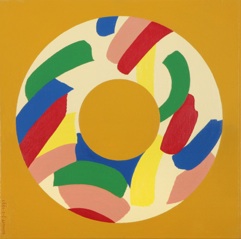The story of Meta-art: not at all a sentimental journey



The story of Meta-art is not the story of sparkling Paris, revolutionary Barcelona or dynamic New York. It is not even the story of hippy Amsterdam. It is the story of a little girl born and raised in the outskirts of Amsterdam. Outskirts that were far away enough from Amsterdam’s roaring centre to hide the fact that this centre existed at all.
Meta-art comes from newly built concrete houses on the pioneering edge of a city growing into modern times. There was sand and emptiness and concrete and silence. But here and there was also a little pond revealing the ever-changing phenomena of natural life: insects, frogs, fishes, water lilies. The little girl watched them carefully for hours. At the sandy edge of the modern city.
Meta-art is the story of a little girl seeing more than anyone around her, knowing that people would not be able to understand her if she told them what she saw. Mainly because she felt that they were indifferent to what she would have to tell. At a very early age she discovered that drawing enabled her to express what was on her mind.
In kindergarten the little girl experienced a moment of extreme lucidity in which she felt without a doubt that drawing would be her lifeline in a life amongst people who would not understand what was going on inside of her. She knew that she and drawing would be alone in this life. And that this was good.
Not long after that she made an ‘impossible’ drawing of a tree, two people and a squirrel. She wanted to meticulously tell the story of these characters and so she erased them every time she had placed them in a certain position. In fact she wanted to draw the flow of time, in a single drawing. But the drawing ended up in bits and pieces of lines that were not erased enough because she had hurried to put the story together in its ever-changing phenomena.
Five years old was the little girl when she tried to draw time itself, sending herself on a mission into the nonsensical. The spirit of Meta-art was born, there and then. Circumstances did not allow her to be familiar with the fact that other minds had already found their way into all kinds of creative expressions that might have stimulated her if only she would have known of their existence. To say it mildly: there was not much interest in art where she grew up.

At ten the little girl got herself some paint and a few brushes. Not much later she will paint a gouache portraying the very state she is finding herself in: a horse leaping into territory never to be reached by the other horses. The horse is just as solitary, just as lonely, as it is sovereign. The position of Meta-art, of the Meta-artist, is defined, there and then.
Meta-art is a doom. It has never been a choice. It had to happen, because it was the only way for the little girl to communicate with the world on the level she experienced the world. It may seem to have taken quite a long time to get at the surface, but in fact this was only a matter of form. The little girl had to find a form to be able to unroll Meta-art at its fullest.
In every ‘ordinary’ painting before Meta-art there is an atmosphere of expectance. The little girl, in the mean time a grown up woman, knows there is a lot more to be portrayed than she portrays in these paintings. But how to portray it?
The grown up girl sometimes leaves the outskirts of Amsterdam and then discovers art at the centre. Van Gogh, Picasso, Mondrian, Vermeer, Rubens.
Art.
And the world surrounding it, where the artist has to find his place.
Immediately the grown up girl falls in love with art. But just as immediately she knows that she will not connect to the world surrounding it. It is art she wants to make, but she doesn’t feel the need to become an artist. Because becoming an artist, she understands, would take her to a level of communication way below the level of communication she was seeking for her mission impossible.
Yes, she fell in love with art; a fiery love where Picasso was concerned. And still, only seeing art for the first time, she already is aware of the fact that even the great expressions of the great artists she falls in love with, do lack what is needed to communicate with the world on the level she is experiencing. She will have to take art to a whole new, never explored level of expression.
Working a small job to pay the rent, becoming the mother of two children, she constantly draws and paints whenever she finds time for it. And gradually she slips into the first forms of expression that will eventually lead to Meta-art. Very striking: every time before a break-through she will create a painting predicting this break-through. Obviously in her mind she already knows what has to be done some while before her hand is able to actually do it...

In 1993, after years of loosely, intuitively, exploration, Meta-art gets at the surface more or less the way Picasso’s Les demoiselles d’Avignon got at the surface in 1907. Insight does not come entirely unexpected, but it still seems so entirely different from everything that was going on, that it seems to have popped up out of nothing. Clear and bright and sovereign like nothing had been sovereign up till then. Something not understandable anymore approached with the usual questions the art of Picasso, Miro, Van Gogh and Mondrian is approached.
Meta-art is born. And with that art was taken beyond the invisible boundaries that kept it within the limits of the possible. The impossible was the new level of artistic expression.
The story of Meta-art is the story of a little girl experiencing how concrete and sand and frogs and human understanding and time and space are inseparably interrelated in ways that are nonsensical to everyday human understanding. It is the story of a little girl who wants to communicate about this awareness in the most comprehensive of ways possible.
Once Meta-art came to light the little girl knew she did not need to go to a gallery, because its owner would not understand what she was doing. Especially because she herself did not understand what she was doing. She felt it without even understanding the beginnings of it. Meta-art came all-intuitively.
The story of Meta-art is also the story of seeing all kinds of media, most of them new, some of them old, passing by, while instinctively knowing that it will be ‘old fashioned’ paint that will be the only medium capable of taking art to the Olympus of human understanding. With that Meta-art is the story of a loneliness never found in any artist at any time at any place. Meta-art is not ‘a different kind of art’, it is a league of its own. Still with its feet in art, but with its head way up in something endlessly more refined and complex.
The little girl wanted to make art and ended up making Meta-art. And when this came about she discovered that the world around art, she had avoided, was not at all able to follow her. As she predicted herself at the age of ten already. Being busy contemplating art, selling art, buying art, explaining art, defending art, day after day, this world cannot imagine that something could surpass the alpha and omega of its daily interests. It likes to see itself as being able to look outside every box, but it does not see that there is a box of such a different character, nobody except the girl recognizes it for what it is: a box of boxes.
And so there is this situation. While the world at large is still, as a matter of speech, creatively living in early 1492, the little girl is the only one already living in late 1493. She sees that the magnificent art of Mondrian and Picasso, heart breaking grand as it may be, is finding itself in the shadow of a much more mature creative expression than both artists could have ever imagined.
The story of Meta-art is the story of something coming from the human mind bearing qualities that come closer to the qualities of this mind itself than anything else that has ever left this mind.

The Meta-artist
as a young girl
